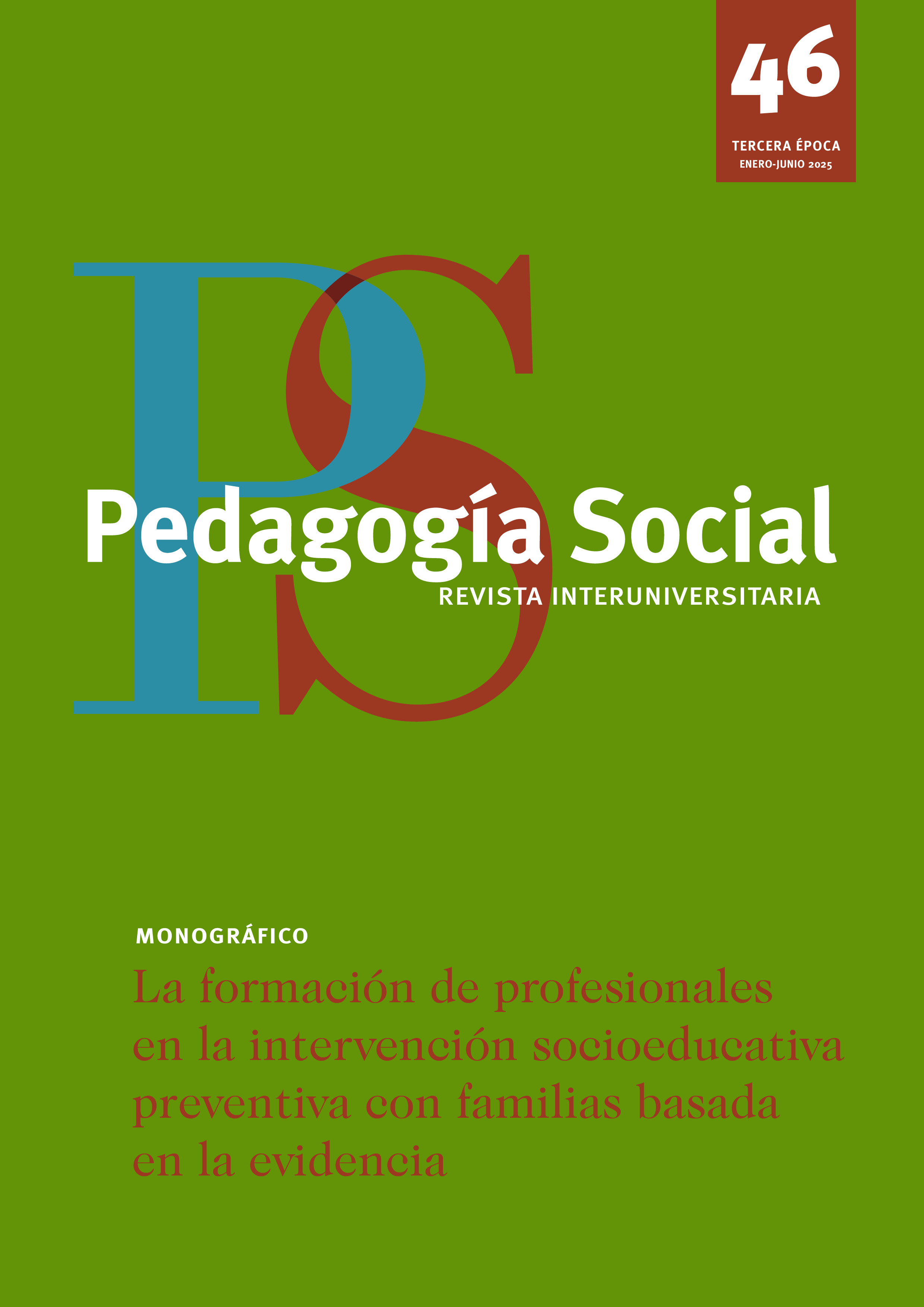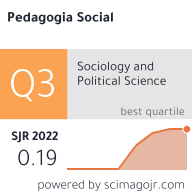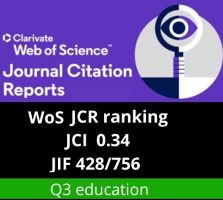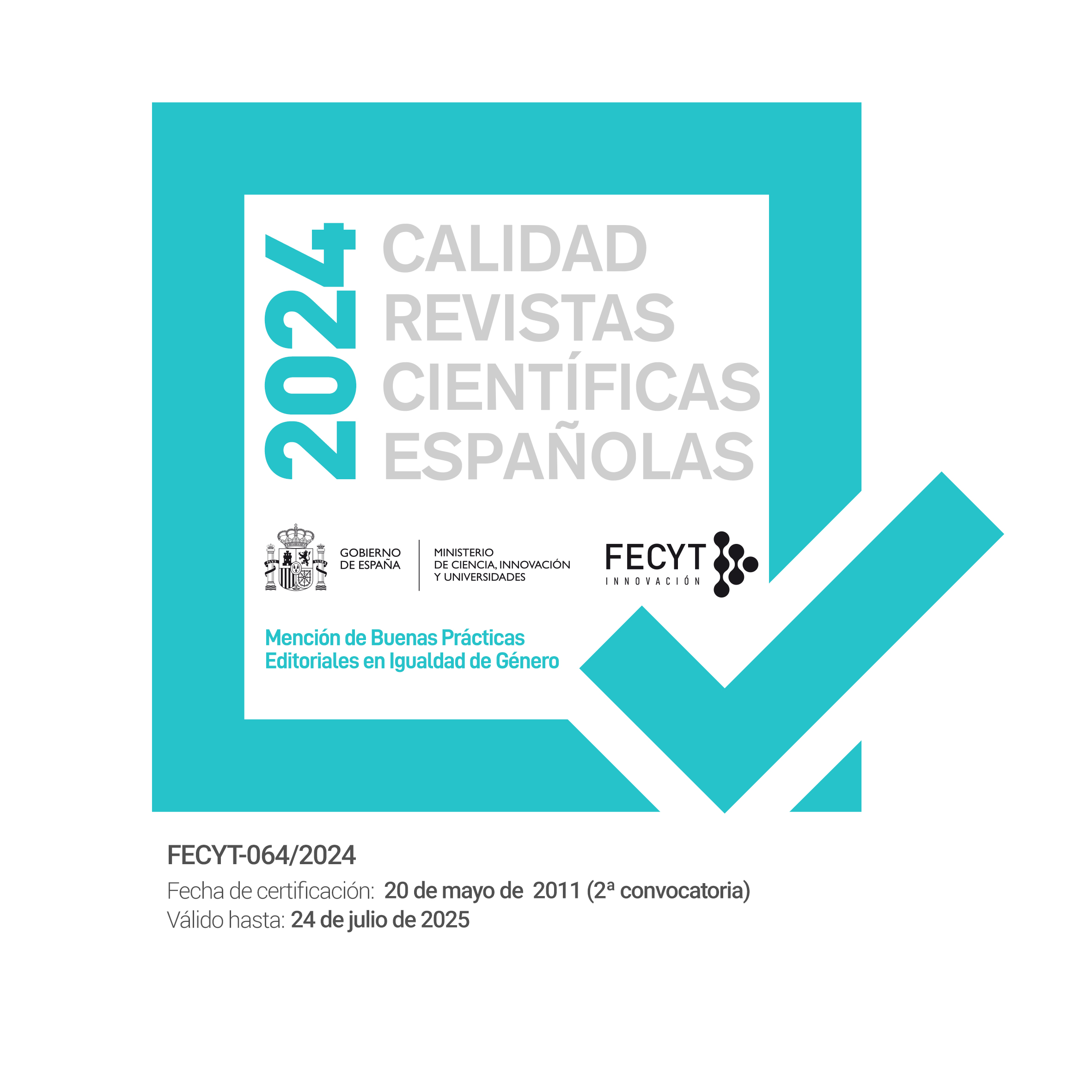Eficácia de um programa de intervenção para a redução do sexismo hostil e benevolente em adolescentes do sexo masculino infratores
DOI:
https://doi.org/10.7179/PSRI_2025.46.11Palavras-chave:
Justiça juvenil, intervenção, viés de gênero, sexismo ambivalente, sexismo hostil, sexismo benevolenteResumo
As atitudes sexistas são um fator de risco tradicionalmente associado à violência contra as mulheres, sendo os adolescentes infratores do sexo masculino um grupo-alvo para a prevenção. O principal objetivo do presente trabalho foi avaliar a eficácia do “Programa de intervenção para a promoção de relações igualitárias”, visando a redução das atitudes sexistas em adolescentes infratores do sexo masculino. Foi realizado um estudo préexperimental com a participação de 104 adolescentes do sexo masculino, com idades entre os 14 e os 21 anos (M = 17.35; ± 0.16), que que cumpriam uma medida judicial de internamento. Foram recolhidos dados sobre atitudes sexistas antes e depois da participação no programa de intervenção, utilizando a Escala de Deteção de Sexismo em Adolescentes (DSA). Os resultados mostraram uma redução significativa das atitudes sexistas hostis e benevolentes apenas nos participantes com níveis elevados de sexismo na linha de base. Em contrapartida, os participantes com baixos níveis de sexismo antes da intervenção registaram um ligeiro aumento das atitudes sexistas hostis. Os resultados demonstraram a utilidade da implementação de programas destinados a reduzir as atitudes sexistas em adolescentes delinquentes, salientando a necessidade de adaptar as intervenções ao nível de risco apresentado, a fim de maximizar a sua eficácia.
Downloads
Referências
Alonso, B., Aranguren, E. y Bacete, R. (2019). El trabajo con hombres desde una perspectiva de género: una asignatura pendiente en la intervención social. Zerbitzuan 69, 23-38. doi:10.5569/1134-7147.69.02
American Psychological Association (2017). Ethical Principles of Psychologists and Code of Conduct. https://www.apa.org/ethics/code
Andrews, D. A. y Bonta, J. (2010). The Psychology of Criminal Conduct (5.º Ed.). LexisNexis.
Asociación Médica Mundial (2013). Declaración de Helsinki de la Asociación Médica Mundial – Principios Éticos para las Investigaciones Médicas en Seres Humanos. https://www.wma.net/es/policies-post/declaracion-de-helsinki-de-la-amm-principios-eticos-para-las-investigaciones-medicas-en-seres-humanos/
Bengtsson, T. T. (2016). Performing hypermasculinity: Experiences with confined young offenders. Men and Masculinities, 19(4), 410-428. doi:10.1177/1097184X15595083
Bonilla-Algovia, E. (2021). Aceptación del sexismo ambivalente en docentes en formación de España y países de América Latina. Anales de Psicología / Annals of Psychology, 37(2), 253-264. doi:10.6018/analesps.441791
Bonilla-Algovia, E., Ibáñez Carrasco, M., y Carrasco Carpio, C. (2022). Validez de la Escala de Detección de Sexismo en Adolescentes (DSA) en Castilla-La Mancha, España. Psykhe, 31(2), 1-12. doi:10.7764/psykhe.2021.28041
Cañete Lairla, M.y Díaz Sánchez, L. D. (2019). La Dependencia Emocional y su Relación con el Sexismo en Adolescentes, International Journal of Sociology of Education, 8(3), 236-260. doi:10.17583/rise.2019.4198
Carrasco Carpio, C., Bonilla-Algovia, E., y Carrasco, M. I. (2021). Sexismo ambivalente en adolescentes de Castilla-La Mancha. Revista de Educación, 392, 97-121. doi:10.4438/1988-592X-RE-2021-392-480
Carrascosa, L., Cava Caballero, M. J., Buelga Vázquez, S., y Jesús, S. N. D. (2019). Reduction of sexist attitudes, romantic myths, and aggressive behaviors in adolescents: Efficacy of the DARSI program. Psicothema, 31(2). 121-127. doi:10.7334/psicothema2018.245
Carretero-Bermejo, R., y Nolasco-Hernández, A. (2017). Aproximación al concepto de emocionalidad. El estereotipo emocional del sexismo || Approach to the concept of emotionality. The emotional stereotype of sexism. Revista de Estudios e Investigación en Psicología y Educación, 4(1), 34-41. doi:10.17979/reipe.2017.4.1.1545
Casey, E., Carlson, J., Two Bulls, S. y Yager, A. (2016). Gender transformative approaches to engaging men in gender-based violence prevention: A review and conceptual model. Trauma, Violence, & Abuse, 19(2), 231-246. doi:10.1177/1524838016650191
Comisión Europea (2020). Una Unión de la igualdad: Estrategia para la Igualdad de Género 2020-2025. Parlamento europeo. https://eur-lex.europa.eu/legal-content/ES/TXT/?uri=CELEX%3A52020DC0152
Conchell Diranzo, R., Lila Murillo, M., y Catalá-Miñana, A. (2016). Intervención con hombres penados por violencia contra la mujer en las relaciones de pareja: el Programa Contexto. Información psicológica, (111), 51-63. doi:10.14635/IPSIC.2016.111.2
Connell, R. W. y Messerschmidt, J. W. (2005). Hegemonic masculinity: Rethinking the concept. Gender & society, 19(6), 829-859. doi:10.1177/0891243205278639
Cormos, L. S., Godoy-Fernández, C., Pina, D., Puente-López, E., García-Jiménez, J. J., Marín-Talón, M. C., y Ruiz-Hernández, J. A. (2023). Violencia de género: perspectiva de condenados y de psicólogos/as de instituciones penitenciarias. Análisis cualitativo con grupos focales. Anales de Psicología / Annals of Psychology, 39(1), 153-166. doi:10.6018/analesps.509091
Cortina, H. y Martín, A. M. (2020). La especificidad conductual de la violencia filio-parental. Anales de Psicología, 36(3), 386-399. doi:10.6018/analesps.36.3.411301
Cuadrado-Gordillo, I., Fernández-Antelo, I., y Martín-Mora Parra, G. (2020). Search for the profile of the victim of adolescent dating violence: an intersection of cognitive, emotional, and behavioral variables. International journal of environmental research and public health, 17(21), 8004. doi:10.3390/ijerph17218004
Cuadrado-Gordillo, I., y Martín-Mora-Parra, G. (2022). Influence of cross-cultural factors about sexism, perception of severity, victimization, and gender violence in adolescent dating relationships. International journal of environmental research and public health, 19(16), 10356. doi:10.3390/ijerph191610356
Cuéllar Otón, J. P. y Hernández Ramos, C. (2021). Violencia de género, condenados e intervención en medio abierto: premisas, avances y retos, Revista Electrónica de Estudios Penales y de la Seguridad (1-22).
https://www.ejc-reeps.com/cUELLAR.pdf
Díaz-Aguado, M. J., Martínez Arias, R. y Martín Barbarro, J. (2014) Evolución de la adolescencia española sobre la igualdad y prevención de la violencia de género. Ministerio de Sanidad, Servicios Sociales e Igualdad, Gobierno de España.
Díaz-Aguado, M. J., Martínez Arias, R. y Martín Babarro, J. (2020) Menores y Violencia de Género. Ministerio de Igualdad, Gobierno de España.
Dosil, M., Jaureguizar, J., Bernaras, E. y Sbicigo, J. B. (2020). Teen dating violence, sexism, and resilience: A multivariate analysis. International journal of environmental research and public health, 17(8), 2652. doi:10.3390/ijerph17082652
Esteban Ramiro, B. y Fernández Montaño, P. (2017). ¿Actitudes sexistas en jóvenes?: Exploración del sexismo ambivalente y neosexismo en población universitaria. FEMERIS: Revista Multidisciplinar De Estudios De Género, 2(2), 137-153. doi:10.20318/femeris.2017.3762
Fernández-Fernández, R., Navas, M. P. y Sobral, J. (2021). What is known about the intervention with gender abusers? A meta-analysis on intervention effectiveness. Anuario de Psicología Jurídica, 32, 23-31. doi:10.5093/apj2021a17
Garaigordobil, M. y Aliri, J. (2013). Ambivalent Sexism Inventory: Standardization and normative data in a sample of the Basque Country. Behavioral Psychology/Psicología Conductual, 21(1), 173-186.
García Pérez, R., Rebollo Catalán, M. A., Buzón García, O., González-Piñal, R., Barragán Sánchez, R. y Ruíz Pinto, E. (2010). Actitudes del alumnado hacia la igualdad de género. Revista de Investigación Educativa, 28(1), 217-232. https://revistas.um.es/rie/article/view/98951
Gibbs, A., Washington, L., Abdelatif, N., Chirwa, E., Willan, S., Shai, N., Sikweyiya, Y., Mkhwanazi, S., Ntini, N. y Jewkes, R. (2020). Stepping Stones and Creating Futures Intervention to Prevent Intimate Partner Violence Among Young People: Cluster Randomized Controlled Trial. Journal of Adolescent Health, 66(3), 323-335. doi:10.1016/j.jadohealth.2019.10.004
Glick, P., y Fiske, S. T. (1996). The ambivalent sexism inventory: Differentiating hostile and benevolent sexism. Journal of Personality and Social Psychology, 70, 491-512. doi:10.1037/0022-3514.70.3.491
Glick, P. y Raberg, L. (2018). Benevolent sexism and the status of women. En C. B. Travis, J. White, A. Rutherford, W. S. Williams, S. L. Cook y K. F. Wyche (Eds.). APA Handbook of the Psychology of Women; History, Theory and Battlegrounds (pp. 363-380) American Psychological Association. doi:/10.1037/0000059-018
González Barea, M. y Rodríguez Marón, Y. (2020). Estereotipos de género en la infancia. Pedagogía Social, 36(2), 125-138. doi:10.7179/PSRI_2020.36.08
González-Ortega, I., Echeburúa, E. y Corral, P. (2008). Variables significativas en las relaciones violentas en parejas jóvenes: una revisión. Psicología Conductual, 16, 207-225.
Guedes, A., Bott, S., García-Moreno, C. y Colombini, M. (2016). Bridging the gaps: a global review of intersections of violence against women and violence against children. Global health action, 9, 31516. doi:10.3402/gha.v9.31516
Ibabe, I., Arnoso, A., y Elgorriaga, E. (2016). Ambivalent sexism inventory: Adaptation to Basque population and sexism as a risk factor of dating violence. The Spanish Journal of Psychology, 19, E78. doi:10.1017/sjp.2016.80
Jewkes, R., Nduna, M. y Jama, N. (2010). Stepping Stones. A training manual for sexual and reproductive health communication and relationship skills. Edition III. Medical Research Council.
Kato-Wallace, J., Barker, G., Garg, A., Feliz, N., Levack, A., Ports, K. y Miller, E. (2019). Adapting a Global Gender-Transformative Violence Prevention Program for the U.S. Community-Based Setting for Work with Young Men. Global Social Welfare, 6(2), 121-130. doi:10.1007/s40609-018-00135-y
Khan, A. R. y Khandaker, S. (2017). Analizando la Masculinidad desde la Óptica Teórica y Buscando Vínculos con la Violencia de Género. Masculinities and Social Change, 6(3), 196–216. doi:10.17583/MCS.2017.2593
Leone, R. M., Parrott, D. J., Swartout, K. M. y Tharp, A. T. (2016). Masculinity and bystander attitudes: Moderating effects of masculine gender role stress. Psychology of Violence, 6(1), 82-90. doi:10.1037/a0038926
López-Garrido, F. M., y Sánchez-Santamaría, J. (2024). ¿Qué opinan las personasjóvenes sobre la violencia en la pareja adolescente? Un estudio cuantitativo desde un enfoque transcultural. Pedagogía Social, 45, 45-62. doi:/10.7179/PSRI_2024.45.03
López-Sáez, M. Á., García-Dauder, D. y Montero, I. (2020). Intersections Around Ambivalent Sexism: Internalized Homonegativity, Resistance to Heteronormativity and Other Correlates. Frontiers in Psychology, 11, 608793 doi:10.3389/fpsyg.2020.608793
Luzón, J. M., Ramos, E., Recio, P. y de La Peña, E. M. (2011). Proyecto Detecta Andalucía: factores de riesgo y de protección en la prevención contra la violencia de género en la pareja. Sevilla: Instituto Andaluz de la Mujer.
Magidson, M. (2020). Youth male identities in a correctional setting. Journal of Gender Studies, 29(2), 202-213. doi:10.1080/09589236.2019.1677457
Malonda, E., Llorca, A., Tur-Porcar, A., Samper, P., y Mestre, M. V. (2018). Sexism and aggression in adolescence–how do they relate to perceived academic achievement? Sustainability, 10(9), 3017. doi:10.3390/su10093017
Marcos-Marcos, J., Nardini, K., Briones-Vozmediano, E. y Vives-Cases, C. (2023). Listening to stakeholders in the prevention of gender-based violence among young people in Spain: a qualitative study from the positivMasc project. BMC Women’s Health, 23(1). doi:/10.1186/s12905-023-02545-3
Martín Cabrera, E., Torbay Betancor, Á. y Alonso Sánchez, J. A. (2024). Mitos del amor romántico y sexismo ambivalente en adolescentes. Pedagogía Social, 45, 137-148. doi:10.7179/PSRI_2024.45.07
MenEngage (2015). Men, Masculinities, and Changing Power: A Discussion Paper on Engaging Men in Gender Equality from Beijing 1995 to 2015. UN Woman. https://www.unfpa.org/sites/default/files/resource-pdf/Men-Masculinities-and-Changing-Power-MenEngage-2014.pdf
Miller, E., Jones, K. A., Culyba, A. J., Paglisotti, T., Dwarakanath, N., Massof, M., Feinstein, Z., Ports, K. A., Espelage, D., Pulerwitz, J., Garg, A., Kato-Wallace, J. y Abebe, K. Z. (2020). Effect of a Community-Based Gender Norms Program on Sexual Violence Perpetration by Adolescent Boys and Young Men: A Cluster Randomized Clinical Trial. JAMA Network Open, 3(12). doi:10.1001/jamanetworkopen.2020.28499
Ministerio de Igualdad (2019). Macroencuesta de Violencia contra la mujer de 2019 [2019 Violence Against Women Macro-Survey]. https://violenciagenero.igualdad.gob.es/violenciaEnCifras/macroencuesta2015/pdf/Macroencuesta_2019_estudio_investigacion.pdf.
Monreal-Gimeno, M. C., Povedano-Díaz, A. y Martínez-Ferrer, B. (2014). Modelo ecológico de los factores asociados a la violencia de género en parejas adolescentes. Journal for Educators, Teachers and Trainers, 5(3), 105-114.
Navarro-Pérez, J. J., Carbonell, Á. y Oliver, A. (2019). The effectiveness of a psycho-educational app to reduce sexist attitudes in adolescents. Revista de Psicodidáctica, 24(1), 9-16 doi:10.1016/j.psicod.2018.07.002
Opsal, T., Aguilar, J., y Briggs, S. (2019). The promises and pitfalls of engaging male juvenile offenders in gender violence prevention and bystander education. Journal of Interpersonal Violence, 34(21-22), 4384-4403. doi:10.1177/0886260516675466
Pérez-Martínez, V., Marcos-Marcos, J., Cerdán-Torregrosa, A., Briones-Vozmediano, E., Sanz-Barbero, B., Davó-Blanes, Mc., Daoud, N., Edwards, C., Salazar, M., La Parra-Casado, D. y Vives-Cases, C. (2023). Positive Masculinities and Gender-Based Violence Educational Interventions Among Young People: A Systematic Review. Trauma, Violence, and Abuse, 24(2), 468-486. doi:10.1177/15248380211030242
Powell-Williams, T., Foley, A. y Davies, K. (2020). “So I Won’t Go to Jail”: Year Two of a PROMUNDO-Adapted Program to Eradicate Gender-Based Violence. Masculinities and Social Change,9(1),85-105 doi:10.17583/MCS.2020.4599
Ramiro-Sánchez, T., Ramiro, M. T., Bermúdez, M. P., y Buela-Casal, G. (2018). Sexism in adolescent relationships: A systematic review. Psychosocial Intervention, 27(3), 123-132. doi:10.5093/pi2018a19
Renner, L. M y Whitney, S. D. (2012). Risk factors for unidirectional and bidirectional intimate partner violence among young adults. Child Abuse & Neglect, 36, 40-52. doi:10.1016/j.chiabu.2011.07.007
Renzetti, C. M., Lynch, K. R., y DeWall, C. N. (2018). Ambivalent sexism, alcohol use, and intimate partner violence perpetration. Journal of Interpersonal Violence, 33(2), 183-210. doi:10.1177/088626051560441
Recio, P., Cuadrado, I., Ramos, E. (2007). Propiedades psicométricas de la Escala de Detección de Sexismo en Adolescentes (DSA). Psicothema, 19(3), 522-528 https://www.psicothema.com/pi?pii=3394
Reyes, H. L., Foshee, V. A., Niolon, P. H., Reidy, D. E., y Hall, J. E. (2016). Gender role attitudes and male adolescent dating violence perpetration: Normative beliefs as moderators. Journal of Youth and Adolescence, 45(2), 350-360. doi:10.1007/s10964-015-0278-0
Ríos-González, O., Torres, A., Aiello, E., Coelho, B., Legorburo-Torres, G. y Munte-Pascual, A. (2024). Not all men: the debates in social networks on masculinities and consent. Humanities and Social Sciences Communications, 11(1). doi:10.1057/s41599-023-02569-y
Rodríguez-Domínguez, C., Durán Segura, M., y Martínez Pecino, R. (2018). Ciberagresores en el noviazgo adolescente y su relación con la violencia psicológica, el sexismo y los celos. Health and Addictions, 18(1), 17-27. doi:10.21134/haaj.v18i1.329
Ruiz S., Negro l., Rui A., García-Moreno C., Herrero O., Yela M. y Pérez M. (2010) Programa de Intervención para Agresores (PRIA). Secretaría General de Instituciones Penitenciarias, Ministerio del Interior, Gobierno de España. https://www.interior.gob.es/opencms/pdf/archivos-y-documentacion/documentacion-y-publicaciones/publicaciones-descargables/instituciones-penitenciarias/Violencia-de-genero-Programa-de-Intervencion-para-Agresores-PRIA-NIPO-126-10-079-4.pdf
Samaniego, E. y Freixas, A. (2010). Estudio sobre la identificación y vivencia de violencia en parejas adolescentes. Apuntes de Psicología, 28, 349-366.
Santa Catalina, M. J. (2021). La violencia de género entre adolescentes: Ley 1/ 2004, de 28 de diciembre. Ley orgánica 5/2000, de 12 de enero, de responsabilidad penal de los menores, y ley 4/2015, de 27 de abril del estatuto de víctima del delito. Revista del Centro de Estudios Jurídicos y de Postgrado CEJUP, (2) 204-211.
Sanz-Barbero, B., Ayala, A., Ieracitano, F., Rodríguez-Blázquez, C., Bowes, N., De Claire, K., Mocanu, V., Anton-Paduranu, D. T., Sánchez-Sandegundo, M., Albadalejo-Blázquez, N., Antunes das Neves, A. S., da Dilva Queirós, A. S., Kankowiak, B., Waszynka, K. y Vives-Cases, C. (2022). Effect of the Lights4Violence intervention on the sexism of adolescents in European countries. BMC public health, 22(1), 1-12. doi:10.1186/s12889-022-12925-3
Shade, K., Kools, S., Pinderhughes, H., y Weiss, S. J. (2013). Adolescent fathers in the justice system: Hoping for a boy and making him a man. Qualitative Health Research, 23(4), 435-449. doi:10.1177/1049732312470520
Sirvent Garcia del Valle, E. (2020). Acceptability of Sexual Violence Against Women in Spain: Demographic, Behavioral, and Attitudinal Correlates. Violence Against Women, 26(10), 1080–1100. doi:10.1177/1077801219854536
Tereškinas, A. (2016). Family in the narratives of good life: Performing masculinities in the lithuanian correctional facilities. Journal of Comparative Family Studies, 47(1), 45-63. doi:10.3138/jcfs.47.1.45
UN Women (2022) Progress on the Sustainable Development Goals the Gender Snapshot 2022. United Nations. https://www.unwomen.org/sites/default/files/2022-09/Progress-on-the-sustainable-development-goals-the-gender-snapshot-2022-en_0.pdf
Verbeek, M., Weeland, J., Luijk, M., y van de Bongardt, D. (2023). Sexual and Dating Violence Prevention Programs for Male Youth: A Systematic Review of Program Characteristics, Intended Psychosexual Outcomes, and Effectiveness. Archives of Sexual Behavior. doi:10.1007/s10508-023-02596-5
World Health Organization (2018). Violence against women, 2018 estimates: global and regional and national estimates of the prevalence of intimate partner violence against women and global and regional estimates of the prevalence of non-partner sexual violence against women. https://www.who.int/es/publications/i/item/9789240026681
Publicado
Como Citar
Edição
Secção
Licença

Este trabalho encontra-se publicado com a Licença Internacional Creative Commons Atribuição-NãoComercial-CompartilhaIgual 4.0.
Derechos de reproducción y archivo
La versión publicada de los artículos podrá ser autoarchivada por sus autores en repositorios institucionales y temáticos de acceso abierto. No obstante la reutilización total o parcial de los mismos en nuevos trabajos o publicaciones deberá ser autorizada por Pedagogía Social. Revista Interuniversitaria.
Los trabajos publicados deberán ser citados incluyendo el título de la Revista, Pedagogía Social. Revista Interuniversitaria, nº, páginas y año de publicación.
Responsabilidades éticas
Pedagogía Social. Revista Interuniversitaria no acepta material publicado anteriormente en otros documentos. Los/as autores/as son responsables de obtener los permisos oportunos para reproducir parcialmente material de otras publicaciones y citar correctamente su procedencia. Estos permisos deben solicitarse tanto al autor/a como a la editorial que ha publicado dicho material.
Es obligación de Pedagogía Social. Revista Interuniversitaria detectar y denunciar prácticas fraudulentas.
En la lista de autores/as firmantes deben figurar únicamente aquellas personas que han contribuido intelectualmente al desarrollo del trabajo.
La revista espera que los/as autores/as declaren cualquier asociación comercial que pueda suponer un conflicto de intereses en conexión con el artículo remitido.
Los autores deben mencionar en el manuscrito, preferentemente en el apartado del método, que los procedimientos utilizados en los muestreos y controles han sido realizados tras la obtención de consentimiento informado.
La revista no utilizará ninguno de los trabajos recibidos con otro fin que no sea el de los objetivos descritos en estas normas.
Aviso de derechos de autor/a
© Pedagogía Social. Revista Interuniversitaria. Los originales publicados en las ediciones impresa y electrónica de esta Revista son propiedad del Pedagogía Social. Revista Interuniversitaria, siendo necesario citar la procedencia en cualquier reproducción parcial o total.
Salvo indicación contraria, todos los contenidos de la edición electrónica se distribuyen bajo una licencia de uso y distribución “Creative Commons Reconocimiento-No Comercial 3.0 España” (CC-by-nc). Puede consultar desde aquí la versión informativa y el texto legal de la licencia. Esta circunstancia ha de hacerse constar expresamente de esta forma cuando sea necesario.






